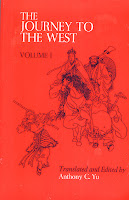 Author: Cheng’en Wu
Author: Cheng’en Wu
Translator: Anthony C. Yu
U.S. publisher: University of Chicago Press
ISBN: 9780226971544
Released: May 1984
Original release: 16th century
The fourth and final volume of Anthony C. Yu’s translation of the Chinese classic The Journey to the West was first published by Chicago University Press in 1983. The volume’s release marked the completion of one of the first and only unabridged English translations of the work. Written anonymously in the 16th Century during the Ming Dynasty, The Journey to the West is believed to be the work of Cheng’en Wu. The Journey to the West is considered to be one of the four great classical novels of Chinese literature. Extremely influential, The Journey to the West is the basis and inspiration for numerous adaptations and countless other creative works from around the world. References to it and its characters are found nearly everywhere. Loosely based on historical events—the sixteen-year pilgrimage of a Buddhist monk from China to India and back— The Journey to the West has taken on a life of its own.
It has been fourteen years since Tripitaka left the T’ang court, charged with the retrieval of sacred Buddhist scriptures from the Western Heaven. The journey, which was only supposed to have taken three years, has been a long and hard one filled with many trials and tribulations. His very survival has depended on the protection and aid of his four divinely appointed companions. Throughout his travels, Tripitaka has suffered repeated attacks and abductions by fiends and demons. Now that he is finally closer to the Western Heaven and his goal, things haven’t gotten any easier for him. He not only has to be wary of monsters, but of mortal humans that threaten him, too. People and politics make his given task even more difficult than it already was. But despite all of his ordeals, Tripitaka perseveres, determined to reach the Western Heaven.
The Journey to the West is a marvelous mix of humor, drama, mythology, fantasy, religion, and manic martial arts. By now Tripitaka’s encounters with fiends and his subsequent rescues have fallen into a fairly predictable pattern. However, there is always some detail that makes each scenario recognizable and sets it apart from all of the others. After more than fourteen years on the road and having to deal with the antics of his unruly companions who only seem to bring him more trouble (from which they then have to save him), Tripitaka is understandably getting to be a little cranky. Although I do feel bad for our poor monk, the result is often hilarious. I like this Tripitaka who is willing to haul out and give his companions a stern talking to, taking them to task for their misdeeds. When he meets a prince who expresses his surprise at the length of their journey, the weary Tripitaka replies, “You have no idea.”
The fourth volume of Yu’s The Journey to the West collects the final twenty-five chapters of the one hundred chapter epic. In addition to the extremely useful endonotes that have been included in each book, the fourth volume also includes the index for the entire set which is also quite handy. But even with these aids it can sometimes be difficult to remember exactly who is who since name changes are a fairly regular occurrence. Tripitaka and his companions alone have several names each that they are known by. The Journey to the West is not a short tale but I found it to be highly entertaining. It’s easy to see why the story is so well loved and has inspired so many creators. For a casual reader, I would probably recommend an abridgement of The Journey to the West, such as Yu’s The Monkey and the Monk. But know that if you do, you’ll be missing out on a lot of great stuff. I, for one, am very glad that I read The Journey to the West in its entirety.



